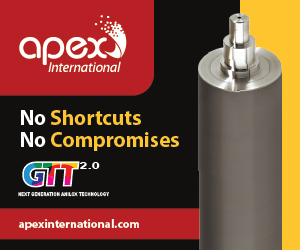Featured Stories
-
Elevating Pouch Manufacturing with Pearl Technologies' Cutting-Edge Solutions
For manufacturers seeking efficiency, precision, and safety in pouch production, Pearl delivers unmatched innovation across three standout... -
Faster Product Composition Analysis Equals Better Quality Assurance
Near Instant Testing and Reduced Costs to be Found -
Methods to Precisely Measure Tension and Web Control
How to Control Automatically Within Set Parameters
News | New Products
-
PACKZ 11 Launches with Industry-First RIP Integration
Plus extended CF2 format and automated support for 2-D Barcodes as Required by the Sunrise 2027 Initiative
-
Double E Group Acquires CAC, Further Enhancing its Strength in the Global Converting Industry
Double E Group, a global leader in converting components and web handling technology, has announced its acquisition of Converter Accessory Corporation (CAC)
-
Nobelus Launches Entry-Level Komfi® Thermal Laminator
FINISHING SOLUTIONS SUPPLIER OFFERS NEW JUNIOR 52 LAMINATING SYSTEM
-
Double E Group Mourns the Loss of Founder and Converting Industry Pioneer, Richard Edward Flagg
Double E Group announces with profound sadness the passing of its founder, Richard Edward “Ed” Flagg, on June 23, 2025. He was 85.
-
Convertech Brand to Fully Transition to Double E Group Same Team, Same Excellence, Unified Name
Double E Group has announced that Convertech, one of its subsidiaries and a trusted provider of core chucks and shaft solutions for the converting industry, will now operate solely under the Double E Group brand.
-
Pulse is Making Print Simple at Labelexpo Europe 2025
Narrow web ink specialist Pulse is Making Print Simple at Labelexpo Europe 2025, as it challenges flexo printers to rethink how they work and shows solutions that turn production bottlenecks into revenue generators.
-
ROTOCON to debut at Labelexpo Europe with three machine demonstrations
ROTOCON will make its Labelexpo Europe debut, exhibiting together with HS Machinery on stand 4D21.
Expert Advice
What Is Cationic UV Technology?
- Published: February 29, 2004, By Dr. Richard M. Podhajny, Ph.D., Contributing Editor
Cationic UV (ultraviolet)-curable inks and coatings have been offered commercially for more than 30 years, but to many printers and converters, it still is a “new technology.”
Cationic UV technology was developed early in the 1960s and initially focused on photo-resist applications. In the early '70s, as UV free radical use grew, cationic UV inks and coatings were developed commercially and used in converting plants. As the technology grew, UV free radical inks found application in offset printing applications for metal can decoration and in lithographic printing applications.
Cationic UV ink technology lagged behind due to raw material limitations, and as a result, UV free radical-based inks became the dominant radiation-curable ink technology. At the same time, cationic UV coating technology, which had outstanding potential, had inherent compatibility issues with many conventional inks as well as UV free radical inks.
Cationic UV inks could be “poisoned” by amines, which were common ingredients in UV inks as well as conventional inks. The less troublesome course was to use UV free radical coatings in combination with UV free radical inks. Early success of UV inks combined with UV coatings was based on free radical chemistry.
Although both technologies rely on high-energy UV radiation to dry the inks via a photo-initiator to start the rapid photo polymerization, this is about where the similarities end.
Free radical UV inks and coatings depend on the generation of photo-induced decomposition of photoinitiators that produce fragments that contain an unpaired electron — a free radical. Such unpaired electron species are “hot” and chemically react rapidly with unsaturated monomers to produce free radical polymerization.
Free radical polymerization can be inhibited by acids and proton-donors, but in general they are catalyzed by amines. Oxygen can scavenge the free radicals by forming peroxides that inhibit or delay the free radical curing process.
Cationic UV inks and coatings generate a photo-induced decomposition of a photoinitiator, which leaves a positively charged fragment, called a “cation.” This cation can take the form of an electron-deficient species such as a Lewis acid. Such electron-deficient or cationic intermediates are “hot” and chemically will react rapidly with epoxide monomers and similar chemicals to produce a cationic polymerization. Cationic polymerization is inhibited by amines and certain electron donor chemicals.
Among the interesting differences between these technologies is that cationic UV systems typically produce systems with better adhesion as well as lower odor characteristics. The reasons for these differences lie in the inherent differences in the raw materials and the chemistry of the reactions. Whereas UV free radical chemistry brings unsaturated monomers together, and in doing so often will show film shrinkage, cationic UV systems open the epoxide strained ring, which expands or at least limits the shrinkage at the molecular level.
In addition, since the polymerization is cationic, oxygen inhibition is not applicable, and unless there are some chemical inhibitors in the ink film, the cationic cure can proceed without inhibition. This fosters higher molecular weight in the polymerization and produces excellent product resistance.
Today, cationic UV systems are available in the form of inks, coatings, and adhesives. Their growth has been noteworthy in Europe, and applications have been commercialized in the use of UV cationic flexo inks as well as cationic UV-curable adhesives. Cationic low-shrinkage characteristics make cationic UV a suitable choice for shrink-wrap applications.
UV technology was commercialized in the '70s to deal with volatile organic compound solvent emissions. With the downturn in the global economy, its superior productivity advantages have propelled its application in a variety of printing and converting processes. Demands for high print quality as well as the unique “feel” of UV-cured products continue to drive the UV inks and coatings markets.
Cationic UV technology clearly has a role to play in flexible packaging. Its unique characteristics are a good fit for many applications in which UV free radical chemistry may not be adequate. While it may not be suitable for all applications, where it can be used, cationic UV technology offers an excellent alternative to free radical UV polymerizeable systems.

Dr. Richard M. Podhajny has been in the packaging and printing industry for more than 30 years. Contact him at 267/695-7717; rpodhajny@colorcon.com.






















